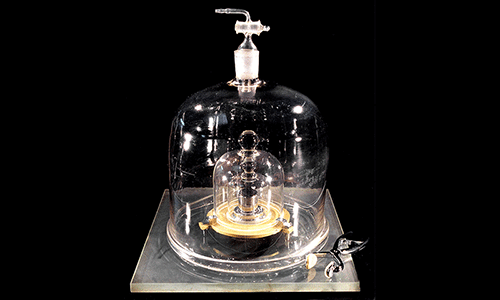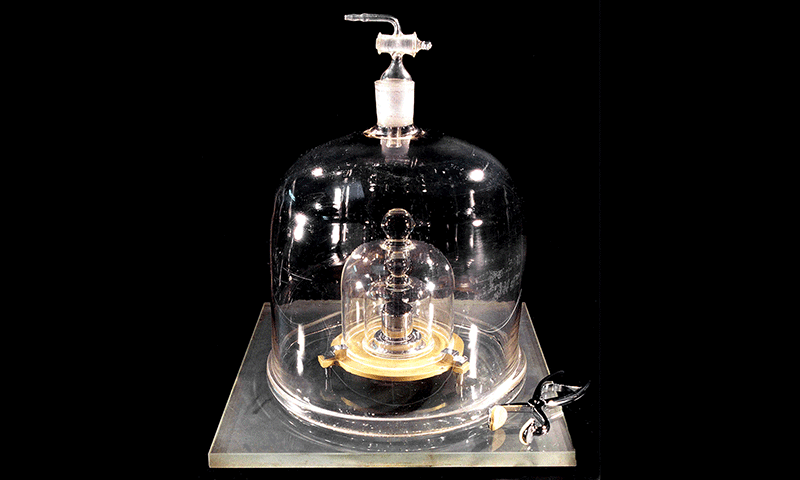Kilogram Untethered from Earthly Objects
It’s official. The world has voted to stop anchoring its measurement system to chunks of metal sitting under glass jars inside locked vaults. The decision was made at the final day of the 26th meeting of the General Conference on Weights and Measures (CGPM) in Versailles, France. The member states voted unanimously to adopt new definitions for four of the seven base units of the International System (SI): the kilogram, the ampere, the kelvin, and the mole. Going forward, corresponding measurements of mass, current, temperature, and the amount of a substance will be based on physical constants, such as Planck’s constant and the elementary electric charge.
Revolution was in the air at the Palais des Congrès—just a stone’s throw from the Palace of Versailles—where the metrological community gathered to overthrow old “rulers.” Many in the room were especially anxious to say goodbye to the international prototype of the kilogram, which was created in 1889. A replica of this platinum-iridium standard was exhibited during the morning sessions of the CGPM. When it was later escorted out, the audience—aware of the symbolic moment—applauded its departure.
The real prototype is—and will continue to be—kept in Paris at the International Bureau of Weights and Measures (BIPM), the arbiter of global measurement standards since the Meter Convention in 1875. As part of its responsibilities, the BIPM has guarded the kilogram prototype, as well as the meter prototype, allowing other metrological institutions from around the world to come and check their standards. But these artefacts change with time, as evidenced by comparisons of kilogram standards. Bill Phillips, a Nobel Prize winner and strong advocate for redefining the SI, drew attention to the problems presented by such an instability in his talk at the conference. He asked what would happen if a fingerprint got on the kilogram prototype and increased its mass. “All of you would lose weight,” he replied.
The whole business of basing units on relics from the 19th century seems quaint—incongruent with our current world of lasers, quantum computers and space travel. Many decades ago, scientists began to demand a more precise, more stable measurement system. The first to succumb to this desire was the meter, which in 1983 was redefined in terms of the speed of light. Rather than taking out a meter stick and measuring how fast light moves, we now let light tell us how long a meter is.
Now it’s the kilogram’s turn to be freed from its Earthly shackles. Going forward, the kilogram will be eternally tied to Planck's constant. In fact, what the science community has done is define Planck's constant as a specific value: h = 6.62607015 × 10-34 J∙s. There are no more error bars here. And it no longer makes any sense to measure Planck’s constant. Everything else—the kilogram included—must adjust to this definition.
Does this new kilogram standard mean we have to abandon our old ways of measuring mass? No, said BIPM Director Martin Milton during the CGPM press briefing. “Nothing is going to change for bathroom scales,” he assured. The difference will be more apparent down the road, as the new kilogram is “future-proofed” for mass measurements in space or on microchips, Milton explained.
A bigger change will occur for electronic measurements, as the ampere switches to a new definition based on the elementary electric charge (see Viewpoint “A New Era for the Ampere”). This realignment will essentially retire two other parameters from condensed matter physics, the Josephson constant and the von Klitzing constant, as the values of both these numbers will be set precisely by the Planck constant and the elementary charge. Klaus von Klitzing, the Nobel Prize winner for the quantum Hall effect, spoke about this changeover during his conference talk. He said he was perfectly happy to sacrifice his namesake for the greater good of placing all the units on a more universal basis.
Von Klitzing also spoke about Max Planck and his early efforts to reformulate the measurement system based on constants of Nature. Planck’s motivation was to have scientific units, “which necessarily retain their significance for all cultures, even unearthly and non-human ones.” We might imagine one day communicating with one of these “cultures” living across the Galaxy on a distant planet. The advantage of the new kilogram definition is that we could actually tell them precisely how much we weigh without sharing any sort of reference mass.
–Michael Schirber
Michael Schirber is a Corresponding Editor for Physics based in Lyon, France.
See Viewpoint "A New Era for the Ampere"
See Focus story "Landmarks—Accidental Discovery Leads to Calibration Standard"





